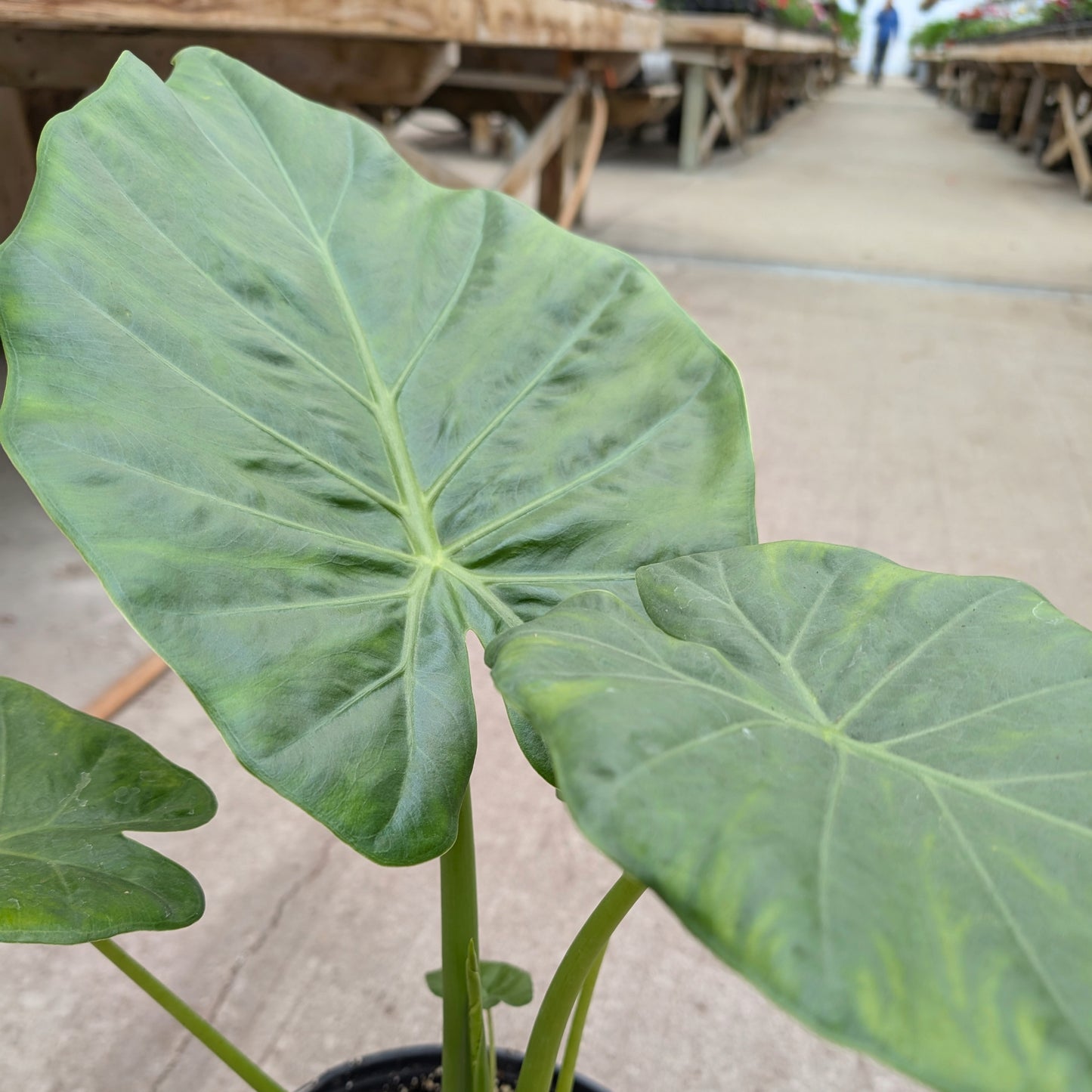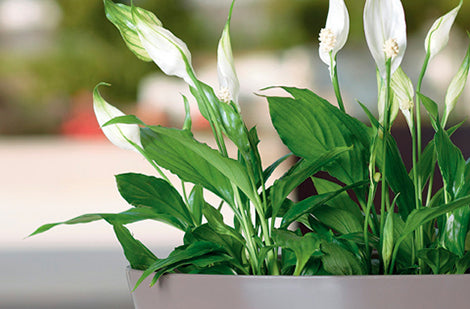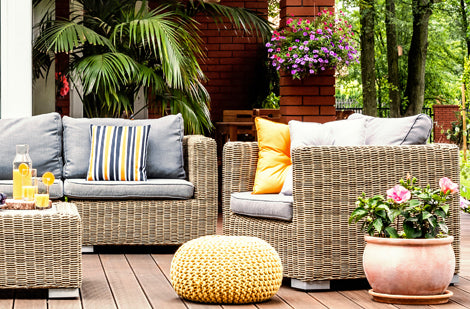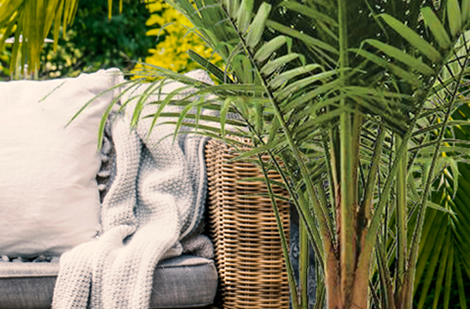Alocasia 'Calidora'
Alocasia 'Calidora' – Elephant Ear
Alocasia 'Calidora' – Elephant Ear
Exposure
- Bright brightness without direct sunlight
- Medium brightness without direct sunlight
Rusticity
- Spectacular giant foliage
- Glossy, vibrant green leaves
- Upright vase-shaped habit
- Dramatic tropical touch
- Ideal as a feature plant
The Alocasia 'Calidora', also known as Elephant Ear 'Calidora', is a herbaceous perennial hybrid from the Araceae family. This tropical plant is prized for its massive, attractive, and very tropical-looking leaves. It brings a spectacular touch and majestic allure to any interior or garden during the warm season.
Key Features
- Foliage: Very large, glossy, bright green leaves, arrow-shaped and strongly ribbed.
- Habit: Upright and erect, with clusters of long stems, forming a very attractive and imposing vase-shaped silhouette.
- Growth: Moderate.
- Care: Moderate to high. Requires specific light, water, and temperature conditions to thrive.
- Appeal: Primarily cultivated for the impressive size and very tropical appearance of its foliage, which makes it a striking focal point.
Care Tips
- Light: Prefers bright indirect light or dappled/partial sunlight. Avoid intense afternoon direct sun that can scorch the leaves. Indoors, place it near a bright window but protected from direct rays.
- Watering: Water regularly to keep the soil moist but well-drained. The soil should never be waterlogged to prevent root rot. Reduce watering in winter.
- Soil: Plant in a well-aerated and well-drained potting mix, rich in organic matter, that retains some moisture. An Aroid mix (such as equal parts coco coir, perlite, and orchid bark) is ideal.
- Humidity: Thrives in high humidity conditions, with humidity above 50%, ideally over 60%. A humidifier or grouping with other plants can help.
- Temperature: Prefers warm temperatures, ideally between 18°C and 29°C (65°F to 85°F). It is sensitive to cold and should never be exposed to temperatures below 10°C (50°F). Avoid cold drafts and sudden temperature changes.
- Fertilization: Fertilize every 1 to 2 months in spring and summer with a balanced fertilizer. Reduce fertilization and watering in winter.
- Pruning: Pruning is not strictly necessary, but old or damaged leaves can be removed to maintain aesthetics and redirect the plant's energy.
- Propagation: Primarily by division of offsets.
- Repotting: Repot every 2 to 3 years, or when the plant is root-bound, in spring. Choose a slightly larger pot with good drainage holes.
Caution: Alocasia 'Calidora' is considered toxic (moderate toxicity) to humans and pets if ingested. All parts of the plant (flowers, fruits, leaves, roots, sap/juice, stems, seeds) contain calcium oxalate crystals that can cause painful irritation of the lips, mouth, tongue, and throat after chewing; difficulty speaking; nausea and diarrhea, vomiting, delirium, and death. Contact with the sap can also cause dermatitis. Handle with extreme caution and keep out of reach of children and animals.
Plant details
Dimensions
Dimensions
Characteristics
Characteristics
Habit:
- Upright
Flowering colours:
Plant needs
Plant needs
Watering:
- Regular
Maintenance:
- Moderate
Soil requirement:
- Well drained
- clay
- silt and sand
Features
Features
Resistance:
Attract:
Use:
- Arrangement - Featured Plant
- Indoor Pot
Attribute:
- Toxic
- Fast growing



Related articles
-

Potting House Plants: which pot to choose
Read the articleBien qu'une plante puisse passer plusieurs mois et parfois même plusieurs années dans le même pot, avec le temps ses racines envahissent tout l'espace disponible. Il devient important de choisir...
-

Moving Up a Level: Advanced Guide to Repotting ...
Read the articlePropagate your violets! Discover the simple cutting method, the secret to the perfect soil mix, and how to fight mealybugs.
-

The Complete Guide to Buying and Caring for Ind...
Read the articleBringing a touch of nature to your home with plants is a great idea! Not only do they beautify your living space, but they also help purify the air. However,...
-

Build Your Own Terrarium: The Complete, Easy Gu...
Read the articleThe terrarium is the perfect addition to your decor! Learn how to easily create your own miniature garden with our complete guide.
-

Create a garden with succulents
Read the articleLes plantes grasses n’ont pas leur pareil pour créer des arrangements à la fois impressionnants par leurs couleurs, leurs formes et leurs textures et faciles à entretenir. Qu’on les agence...
-

Houseplants to discover - Butterfly Palm or Are...
Read the articleDypsis lutescens, anciennement Chrysalidocarpus lutescens
-

Calathea: The Essential Guide to Mastering the ...
Read the articleCalathea is a stunning addition, but it's demanding! The key to its success? Humidity. Find out why tap water and dry air are its worst enemies and how to give...
-

Jade Plant (Crassula): The Easy-Care Succulent ...
Read the articleThe jade plant is a must-have! Learn all the secrets to caring for this resilient succulent that naturally grows into an elegant miniature tree.
-

Madagascar Dragon Tree: Embrace Effortless, Gra...
Read the articleAdd a modern touch to your home! The Madagascar Dragon Tree is low-maintenance, perfect for beginners, and stands out with its slender look and two-toned foliage.
-

Aspidistra: The "Cast Iron Plant" Indestructibl...
Read the articleDon't have a green thumb? The Cast Iron Plant is for you! Tolerant of shade and missed waterings, it's perfect for lobbies and offices. Learn how to maintain its leathery...
-

Embrace the Fern: The Champion of Shade and Tro...
Read the articleGot a dark corner? Ferns are your allies! They are easy to care for if you master one factor: humidity. Learn how to water them perfectly for spectacular and full...
-

-

Kalanchoe: The Secret to Massive Blooms That La...
Read the articleNeed lasting colour? The Kalanchoe blooms profusely for over two months! An easy succulent that tolerates neglect and adds a vibrant touch to your home.
-

Snake Plant: The Unkillable Houseplant, Perfect...
Read the articleThe Snake Plant is an ideal houseplant for everyone, whether you're a beginner or an experienced gardener. Its resilience, ease of maintenance, and decorative appearance make it an essential choice...
-

Edible Flowers: Top 5 for Garden and Kitchen
Read the articleOffrant une belle gamme de couleurs, de formes et de textures, les fleurs comestibles enthousiasment les amoureux de jardinage et de cuisine.
-

Tropical Flowering Plants: A touch of the exoti...
Read the articleLes plantes tropicales à fleurs ont tout pour faire tourner les têtes! Colorées, odorantes, généreuses, elles n’ont pas leur pareil pour égayer une aide de repos, un balcon, une terrasse....
-

Keep a palm tree on the terrace - why not!
Read the articleDifficile de résister à l’appel des tropiques quand le soleil et les températures clémentes se pointent le bout du nez. Rien de mieux qu’un palmier sur la terrasse ou le...
-

Bring Your Plants Indoors for Winter: The Compl...
Read the articleDon't get caught by the first frost! Prepare your outdoor plants for winter with our complete guide.
-

When and how to repot house plants
Read the articleAlthough a plant can spend several months and sometimes even several years in the same pot, over time its roots invade all the available space.
-

Choosing the best potting soil for your indoor ...
Read the articleDon't let your plants stall: learn how to choose the ideal potting mix and optimize drainage for vibrant foliage.




























